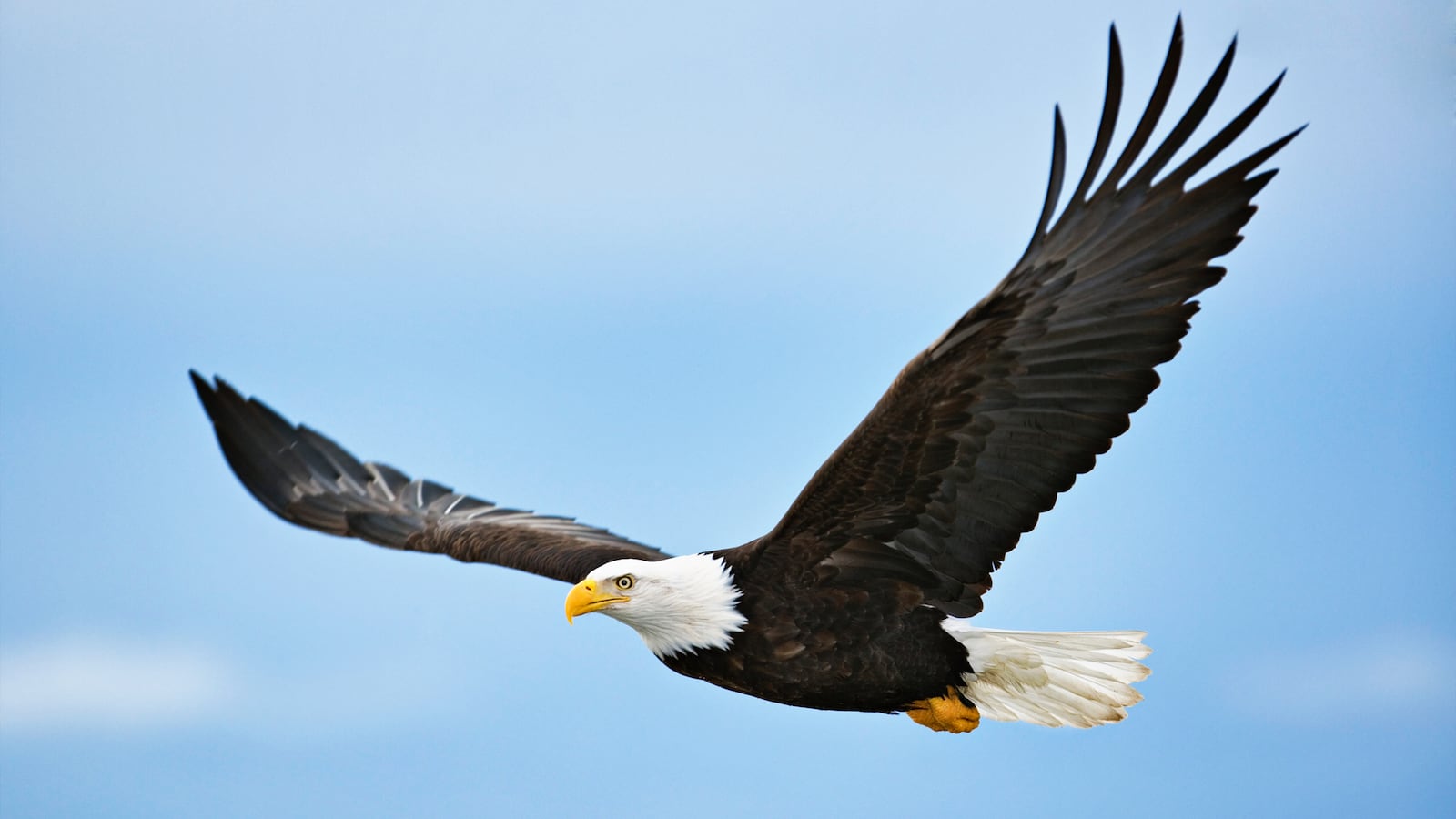The United States adopted the bison as its national mammal in 2016. Before that, it made the oak the national tree and the rose the national flower. But the United States has never done what every state of the union has done: adopt a designated feathered representative. The national bird is, officially, nonexistent. Every reader right now is thinking or saying out loud—shouting even—What?! Of course the U.S. has a national bird. It’s the bald eagle! Even U.S. government websites make that claim. But the government is, well, wrong.
The position for national bird remains vacant. No president or Congress has ever signed a proclamation or passed a law to fill it. Ever since Congress affixed the bald eagle on the Great Seal of the United States in 1782, the white-headed raptor has falsely basked in the position of national bird. Yet tomorrow, the day after, or next week the president could, with a small group of vested onlookers gathered around, put an executive pen to an executive order to grant the honor of national bird to the cardinal, oriole, jay, or, yes, sidewalk pigeon.
Benjamin Franklin wanted the turkey displayed on the Great Seal and as a national symbol. Everybody knows that too. Or did he? Any American familiar with the least bit of bald eagle trivia seems to know about Franklin’s legendary displeasure over the bald eagle’s reigning status and his desire to appoint the turkey in its place. The basis for this alleged preference lies in his taking exception to the obnoxious penchant of bald eagles for stealing fish from ospreys. He believed that the turkey, which would never commit such a degenerate crime, was, by comparison, a model citizen of the avian community. The truth is that Franklin’s desire for the turkey ranks with the best of fictional fable, alongside young George Washington’s cherry-tree honesty and John Henry’s steel-driving tenacity.
The tale of Franklin and the birds dates to the early nineteenth century, after he shared his views of the eagle and turkey in a 2,129-word letter to his daughter, Sarah Bache. He devoted the majority of those words to expressing his disapproval of the Society of the Cincinnati. The society was founded in 1783, a year after the adoption of the Great Seal, to preserve the ideals, values, and memory of the French and Continental army officers who served in the Revolutionary War. Only those officers—not common soldiers—and their firstborn male descendants could join the society. Washington was a founding member, as was Alexander Hamilton, Aaron Burr, James Monroe, Henry Knox, John Paul Jones, Light Horse Harry Lee, even King Louis XVI. Critics, who included John Adams and Thomas Jefferson, accused the society of validating a hereditary nobility common to Europe but foreign to the democratic ideals of the U.S. Franklin derided Cincinnati as an “Order of Knights” formed in “direct Opposition to the solemnly declared Sense of their Country.” Induction came with a medal, a consolation for members who, Franklin maintained, were envious of the “ribbands and crosses they have seen hanging to the button holes of foreign officers.”
The centerpiece of the medal, and suspended from a blue ribbon edged in white, was a bronze bald eagle. Initially, many of the American veterans invited to join the organization rejected the society. Then, Major Pierre Charles L’Enfant, a French military engineer who would go on to design Washington, D.C., arrived from France with a “bundle of eagles.” As Thomas Jefferson told the story, the eagle medals “at once, produced an entire revolution of sentiment” in favor of joining the society.
Franklin was on a tear when he mentioned the organization’s insignia in the letter to his daughter. His ranting about democratic values and elitism pivoted him into a summary assessment of the bird on the Great Seal. “For my own part I wish the bald eagle had not been chosen as the representative of our country. He is “a bird of bad moral character” who “does not get his living honestly.” The species that purportedly suffered the bald’s crimes the most was the industrious osprey, a.k.a. the “fish hawk.” “Perched on some dead tree,” the eagle “watches the labour of the fishing hawk; and when that diligent bird has at length taken a fish, and is bearing it to his nest for the support of his mate and young ones, the bald eagle pursues him, and takes it from him.” Franklin did not mince words. In his estimation, the bald was a lazy, thieving breed, a false noble, and “rank coward.” To drive home his point, he drew a comparison with the turkey, a “little vain and silly tis true” but “much more respectable” and full of “courage.” He also appreciated the turkey as “peculiar to” the United States, while eagles “have been found in all countries.”
He was, of course, wrong about the bald eagle’s range, and that of the turkey too, which lives throughout much of the Western Hemisphere. Whether the turkey is a plucky bird, as Franklin maintained, is arguable. It is certainly shrewd, having endured among Americans, who consider it most suitable for the serving plate. But it isn’t an exceptionally dignified-looking animal, as Franklin admitted: a “little vain and silly tis true.” From skinny neck up, it’s all jiggle and shrivel framing round-eyed befuddlement. The gobbling doesn’t help. Its pear-shaped body suggests docility, the opposite of the bald eagle’s broad-shoulder mettle (some heraldic depictions in Europe showed eagles posing with wings open in the manner of a strong man flexing his biceps). The turkey is a decent sprinter, yet anything but a flying ace. It’s a close-to-ground aviator with an aerial range of about a quarter mile, although its usual is from ground to tree branch—where it perches at night in fear of predators. The bald fears none, and it is capable of divine heights, in line with the ambitions of a rising nation.
No one knows whether Franklin’s commentary was even sincere. You could never tell with him. The lover of a good joke—his especially—he confessed elsewhere that he was characteristically given to “Prattling, Punning and Joking.” One can add counterfeit. He disguised his hugely popular Poor Richard’s Almanac as the musings of an unprosperous farmer named Richard Saunders. Saunders was a fiction, and the almanac was parody and fable from Franklin’s pen and printing press. The “best satires” that came off that press, says historian Jill Lepore, were “relentlessly scathing social and political commentary attacking tyranny, injustice, ignorance,” the same sort of writings with which he flailed the Society of the Cincinnati. His views of less serious matters, such as the temperament of a bird, could change for literary convenience. Poor Richard’s once described the bald eagle not as cowardly but as “fierce.” Franklin was America’s Mark Twain before Mark Twain. Even in letters, writes Lepore, “he couldn’t always govern his wit.”
Nor could he control his duplicity. On July 4, 1789, the year in which the U.S. Constitution went into force, the Society of the Cincinnati elected Franklin an honorary member, an honor he accepted. Nor did he object when the French referred to Franklin the foreign diplomat as the “Eagle of the West.” In his experiments generating electricity using Leyden jars, he once wired up a turkey, “about ten pounds weight,” to see whether electrocution would kill it. It did. He was later quoted as saying, “Birds killed in this manner eat uncommonly tender.” Was he joking?
As for the letter, Franklin more than likely composed his complaint as an opinion piece masquerading as a private missive that he intended to leak to the public. Politics was not a subject he discussed with his daughter—at least, not in correspondence—and he never sent the letter in question to her. He never apparently leaked it either. The public got wind of it after his grandson William Temple Franklin published a collection of his late elder’s writings. That was twenty-seven years after Franklin’s death. By then, Franklin’s opinion would not have swayed anybody. The bald eagle as a symbol was immensely popular within the government and among the people.
It is no surprise, then, that the potshots Franklin took at the bald eagle created something of a chuckling sensation. His criticisms and caprice, however, are only a small part of the story in establishing—discovering, actually—a founding bird. It is true that he objected to the bald eagle’s exalted cultural status. It is equally true that he never expressly said in a letter or anywhere else that he preferred the turkey as a national symbol. As it happens, he did not want the turkey; he wanted Moses. Yes, the biblical Moses.
Excerpted from The Bald Eagle: The Improbable Journey of America’s Bird. Copyright (c) 2022 by Jack E. Davis. Used with permission of the publisher, Liveright Publishing Corporation, a division of W. W. Norton & Company, Inc. All rights reserved.





